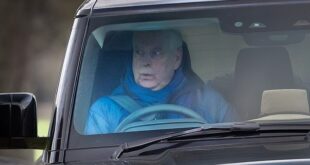You don’t reach 70 years as monarch without becoming very deeply ingrained in British culture.
By the time Queen Elizabeth II died a year ago today, she was the only head of state most of the country had ever known.
So it should come as no surprise that reminders of her reign are still all around us – the inertia of seven decades doesn’t disappear overnight.
Some of us may have started to notice King Charles popping up in the places where his mother’s image, title or cypher used to appear – on our passports, for example, or the change in our pocket – but it’s very much a work in progress.
Here are some of the biggest changes that have been made in the past year… and a few that we’re still going to have to wait for.
National anthem
This is one that caught many people out at first. At the moment King Charles acceded to the throne, the words to one of the UK’s most familiar songs changed.
There are clips of the crowd spontaneously singing ‘God Save the Queen’ outside Buckingham Palace in the hours after the Queen’s death, before doing a rendition of the now-correct ‘God Save the King’.
The first official performance of God Save the King in 70 years came on September 10 last year, at the end of a memorial service for the Queen at St Paul’s Cathedral in London.
It may be a while before we hear God Save the Queen sung as the national anthem again, as the next two people in the line of succession – Princes William and George – would be King.
Cash
The historian and chairman of the National Portrait Gallery Sir David Cannadine once described Queen Elizabeth as ‘the most portrayed woman in history’.
There’s a chance that’s true merely taking into account official portraits – but what puts the statistic beyond doubt is the fact that her image has been printed on billions upon billions of coins and banknotes in the UK and across the Commonwealth across seven decades.
As we start to use cash less often than ever, it seems unlikely any future monarch will match those numbers.
But those people who do still carry change may have noticed the profile of King Charles III – as created by sculptor Martin Jennings – appearing on their 50p coins already, after they were introduced into circulation last December.
The Royal Mint said it could not comment on when other denominations with the face of the new monarch will start to appear, as the coins will be released according to demand.
Meanwhile, the Bank of England has said it anticipates debuting the King Charles banknotes in the middle of next year after unveiling them last December.
A spokesman said ATMs, vending machines and note scanners will all need to have their software updated to recognise the new image, a process that is going to take ‘several months’.
Flags and Regiments
People who don’t have a link to the Armed Forces may not realise just how intertwined its imagery is with the monarchy.
More: Trending
Ahead of King Charles’ coronation this year, 46 of the British Army’s 74 Regiments and Corps revealed their new cap badges, which had been changed to reflect the new head of state.
Several of them used Queen Elizabeth’s ‘EIIR’ cypher, which needed to be changed to King Charles’ ‘CRIII’ one, and even more used the St Edward’s Crown most commonly associated with the late Queen, which needed to be swapped with the King’s Tudor Crown.
The new cap badges, which included those used by renowned regiments such as the Grenadier Guards and the Royal Gurkha Rifles, were distributed to military personnel working the coronation.
However, it’s understood that most cap badges, buttons, regimental flags and other items carrying the previous cypher and/or crown will only be replaced when wear and tear makes it necessary.
Stamps and Postboxes
As with the aforementioned 50p coins, you may have noticed King Charles stamps starting to appear, though some shops might still be making their way through older stocks.
They were first unveiled at London’s Postal Museum in February, and have been available to buy since April 4.
Like coins, stamps are something of a victim of the extraordinary technological changes that took place over the course of Elizabeth’s reign, and are far less necessary in everyday life now than they were when she was crowned in 1953.
Postboxes are a little more complicated: they bear the cypher of the monarch who was on the throne when they were installed, so all the ones that currently have ‘EIIR’ on them will continue to do so until they’re no longer in use and get removed.
A Royal Mail spokesperson said that includes ‘any post boxes already in production or being prepared for installation’, and that ‘there have been no postboxes bearing the King Charles cypher installed’.
They added: ‘Announcements about the installation of postboxes bearing the cypher of King Charles will be made at the appropriate time.’
Passports
The inside cover of UK passports mentioned ‘Her Britannic Majesty’ for more than 10 months after the death of the Queen on September 8 last year.
But if you received a new passport after July 18 this year, you’ll see the wording has now changed to bear the title of ‘His Majesty’.
At the time, Home Secretary Suella Braverman said: ‘For 70 years, Her Majesty has appeared on British passports and many of us will not remember a time when she did not feature.
‘Today marks a significant moment in UK history, as the first British passports since 1952 start featuring the title of His Majesty, the King.’
Those of us who still have the old salutation shouldn’t fear though – every passport is valid until its date of expiry, no matter which monarch is requesting and requiring that all those whom it may concern allow the bearer to pass freely without let or hindrance.
Get in touch with our news team by emailing us at webnews@metro.co.uk.
For more stories like this, check our news page.
Get your need-to-know
latest news, feel-good stories, analysis and more
This site is protected by reCAPTCHA and the Google Privacy Policy and Terms of Service apply.







